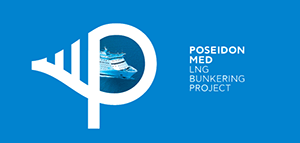
Design studies:
As POSEIDON MED II is the continuation of previous projects, vessels which were studied formerly will now be studied in more detail and depth. Five vessels have already been selected from POSEIDON MED, one from ARCHIPELAGO LNG, and four new vessels that will all form a pool of ten (10) candidate vessels for LNG retrofit.
The aim of the POSEIDON MED II project is to prepare the technical designs of the 10 vessels to be converted into LNG-fuelled ships, including the design of Bunker Vessels, and LNGfuelled new builds. Their financial attractiveness will also be considered.
The candidate vessels for a process of retrofitting include: a large cruise ferry, large ro/pax ferries, one high speed catamaran ferry, one pure car carrier, one bulk/container carrier, a utility tug, an open type car ferry, which are dedicated to the Mediterranean trade.
The necessary technical steps for LNG retrofit of the candidate vessels will be studied, identifying the location of the LNG storage tanks and the type of tanks required, in order to create and operate a functional fleet of LNG fuelled vessels, LNG fuelled bunkering vessels (feeders), as well as the required infrastructure.
The candidate vessels were selected based on the following selection criteria: age, engine to be able to accept retrofit kits in an economical and technically feasible way, availability of data, size of ship. Following this first selection criteria, a thorough engineering evaluation was undertaken.
The candidate vessels are to be linked to specific ports, such as the port of Piraeus, port of Patras, and the port of Limassol.
In addition to the 10 candidate for retrofit vessels, the conceptual and detailed design of two new builds will be assessed. Specifically, one at the level of concept design for conventional LNG fuelled vessels and one at the level of detailed design for an innovative ro/pax ferry.
Another area of study will be the basic design of a newly built bunkering vessel, which will use the Port of Piraeus as hub port for LNG bunkering operations. A feeder type LNG tanker, which will be transferring LNG bunkers from Revithoussa LNG Terminal to various ports as needed, will also be studied up to the detailed design level.
Operating procedures at the ports will be explored, specifically, the detailed mechanical and electrical designs of the necessary equipment for handling LNG at the ports will be studied.
Finally, the critical factors and aspects (including know-how and technology) which need to be taken into account in order to evaluate local shipyards’ preparedness will be identified, through consultation processes with local shipyards.

The sole responsibility for the content of this webpage lies with the authors. It does not represent the opinion of the European Communities. The European Commission is not responsible for any use that may be made of the information contained therein.
Website Privacy Policy





